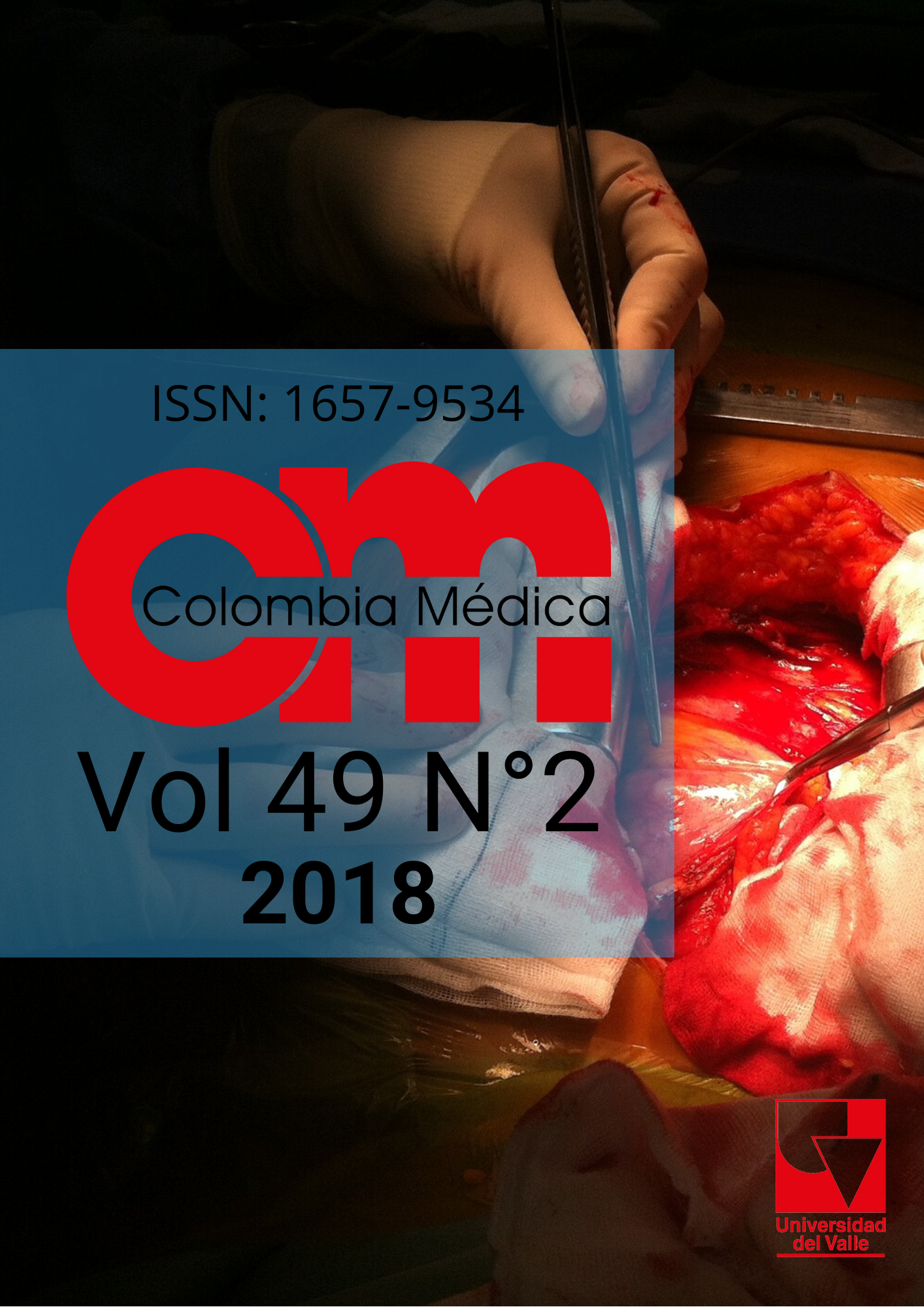Development and validation of anthropometric equations to estimate body composition in adult women
Keywords:
Obesity, fat free mass, fat mass, body fat, fat mass percentage, hydrodensitometry, anthropometry, underwater weighing, validation study, prediction equations.Main Article Content
ICBF. Instituto Colombiano de Bienestar Familiar: Encuesta Nacional de la Situación Nutricional en Colombia 2010. Bogotá, Colombia: Da Vinci Editores & CÍA S N C; 2011.2011.
Cornier MA, Després JP, Davis N, Grossniklaus DA, Klein S, Lamarche B, et al. Assessing adiposity: a scientific statement from the American Heart Association. Circulation. 2011;124(18):1996-2019. DOI: https://doi.org/10.1161/CIR.0b013e318233bc6a
Thibault R, Genton L, Pichard C. Body composition: why, when and for who? Clin Nutr. 2012;31(4):435-47. DOI: https://doi.org/10.1016/j.clnu.2011.12.011
Grundy SM. Adipose tissue and metabolic syndrome: too much, too little or neither. Eur J Clin Invest. 2015;45(11):1209-17. DOI: https://doi.org/10.1111/eci.12519
Kanellakis S, Skoufas E, Khudokonenko V, Apostolidou E, Gerakiti L, Andrioti MC, et al. Development and validation of two equations based on anthropometry, estimating body fat for the Greek adult population. Obesity (Silver Spring). 2017;25(2):408-16. DOI: https://doi.org/10.1002/oby.21736
Waidyatilaka I, de Silva A, de Lanerolle-Dias M, Atukorala S, Lanerolle P. A field tool for prediction of body fat in Sri Lankan women: skinfold thickness equation. J Health Popul Nutr. 2016;35(1):31. DOI: https://doi.org/10.1186/s41043-016-0069-6
Hastuti J, Kagawa M, Byrne NM, Hills AP. Development and validation of anthropometric prediction equations for estimation of body fat in Indonesian men. Asia Pac J Clin Nutr. 2013;22(4):522-9.
Stevens J, Ou FS, Cai J, Heymsfield SB, Truesdale KP. Prediction of percent body fat measurements in Americans 8 years and older. Int J Obes (Lond). 2016;40(4):587-94. DOI: https://doi.org/10.1038/ijo.2015.231
Nevill AM, Metsios GS, Jackson AS, Wang J, Thornton J, Gallagher D. Can we use the Jackson and Pollock equations to predict body density/fat of obese individuals in the 21st century? Int J Body Compos Res. 2008;6(3):114-21.
Bellisari A, Roche AF. Antropometría y ecografía. In: Heymsfield SB, Lohman TG, Wang Z, Going S, editors. Composición Corporal. Mexico, D.F.: McGraw-Hill; 2007. p. 109-128.
Deurenberg P, Deurenberg-Yap M. Validity of body composition methods across ethnic population groups. Acta Diabetol. 2003;40 Suppl 1:S246-9. DOI: https://doi.org/10.1007/s00592-003-0077-z
Durnin JV, Womersley J. Body fat assessed from total body density and its estimation from skinfold thickness: measurements on 481 men and women aged from 16 to 72 years. Br J Nutr. 1974;32(1):77-97. DOI: https://doi.org/10.1079/BJN19740060
Jackson AS, Pollock ML. Practical assessment of body composition. The physician and sport medicine. 1985;13(5):76-90. DOI: https://doi.org/10.1080/00913847.1985.11708790
Ramirez-Zea M, Torun B, Martorell R, Stein AD. Anthropometric predictors of body fat as measured by hydrostatic weighing in Guatemalan adults. Am J Clin Nutr. 2006;83(4):795-802. DOI: https://doi.org/10.1093/ajcn/83.4.795
Aristizabal JC, Restrepo MT, Lopez A. [Validation by hydrodensitometry of skinfold thickness equations used for female body composition assessment]. Biomedica. 2008;28(3):404-13.
Lohman T, Roche A, Martorell R. Antropometric Standardization reference manual. Human Kinetics Publishers; 1988. p. 2-80.
Going S. Hidrodensitometría y pletismografía de desplazamiento de aire. In: Heymsfield SB, Lohman TG, Wang Z, Going S, editors. Composición Corporal. Mexico, D.F.: McGraw-Hill; 2007. p. 17-34.
Heyward VH. Practical body composition assessment for children, adults, and older adults. Int J Sport Nutr. 1998;8(3):285-307. DOI: https://doi.org/10.1123/ijsn.8.3.285
Lohman T. Advances in Body Composition Assessment. Champaign, IL. Human Kinetics Publishers; 1992. p. 1-5.
Landis JR, Koch GG. The measurement of observer agreement for categorical data. Biometrics. 1977;33(1):159-74. DOI: https://doi.org/10.2307/2529310
Sandhu J, Giniya G, Shenoy S. Estimation of body composition in Indian population using skin-fold thickness and body-mass-index-based prediction equations: comparison and validation using under-water weighing machine. International Journal of Body Composition Research 2010 Vol 8 No 2: 51–56.
Medoua GN, Nana ES, Essa'a VJ, Ntsama PM, Matchawe C, Rikong HA, et al. Body composition of Cameroonian lactating women determined by anthropometry, bioelectrical impedance, and deuterium dilution. Nutrition. 2011;27(4):414-9. DOI: https://doi.org/10.1016/j.nut.2010.09.008
Jackson AS, Ellis KJ, McFarlin BK, Sailors MH, Bray MS. Cross-validation of generalised body composition equations with diverse young men and women: the Training Intervention and Genetics of Exercise Response (TIGER) Study. Br J Nutr. 2009;101(6):871-8. DOI: https://doi.org/10.1017/S0007114508047764
Rojas W, Parra MV, Campo O, Caro MA, Lopera JG, Arias W, et al. Genetic make up and structure of Colombian populations by means of uniparental and biparental DNA markers. Am J Phys Anthropol. 2010;143(1):13-20. DOI: https://doi.org/10.1002/ajpa.21270
Price AL, Patterson N, Yu F, Cox DR, Waliszewska A, McDonald GJ, et al. A genomewide admixture map for Latino populations. Am J Hum Genet. 2007;80(6):1024-36. DOI: https://doi.org/10.1086/518313
Downloads

This work is licensed under a Creative Commons Attribution-NonCommercial 4.0 International License.
The copy rights of the articles published in Colombia Médica belong to the Universidad del Valle. The contents of the articles that appear in the Journal are exclusively the responsibility of the authors and do not necessarily reflect the opinions of the Editorial Committee of the Journal. It is allowed to reproduce the material published in Colombia Médica without prior authorization for non-commercial use

